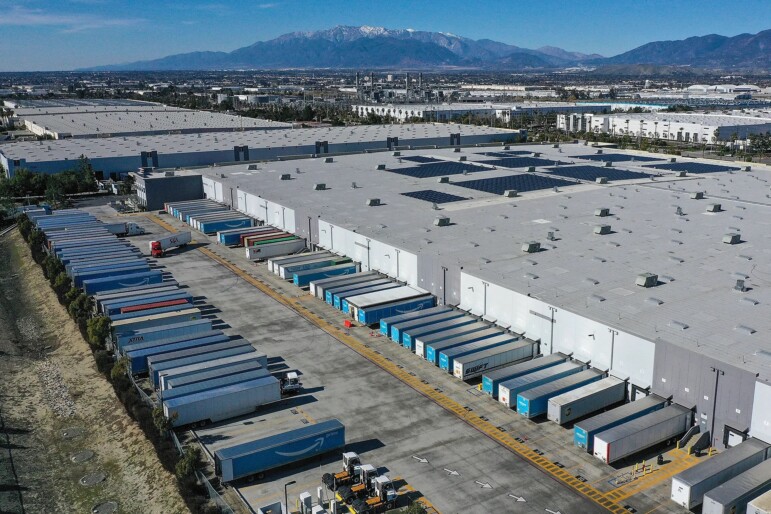Dozens of warehouse workers, delivery drivers, restaurant employees and advocates traveled to San Diego Thursday to urge the California Occupational Safety and Health Agency to take swift action implementing an indoor heat standard.
The California Legislature first directed Cal/OSHA to take up the issue of adding indoor heat regulations to protect workers in 2016. An indoor heat standard would mirror state regulations that protect outdoor workers, including requiring employers to provide breaks, water and other safety measures when temperatures rise to a certain level.
Temperatures already are ramping up around the state; the year’s first record-breaking heat wave is expected to hit this month. But workers warned that desert climates, particularly in the Inland Empire and other parts of Southern California, can bring high temperatures year-round.
The warehouse and logistic industry has grown in the Inland Empire, especially since the pandemic. Some workers complained about heat in warehouses and trucks.
Viviana Gonzalez, a UPS driver in Palmdale and shop steward for the Teamsters 396 Local, told the Occupational Safety and Health Standards Board that in the past nine years she has talked to a number of employees who experienced heart palpitations or suffered heat stroke while working indoors.
She urged the board to be as specific as possible about mandated breaks, cool-down areas, and temperature limits, because lives depend on it.
“We’re out there working in 115 degrees, and the back of the trucks get to 140 or 150,” Gonzalez said.
“Our bodies go through a lot of stress. I’m just here asking you guys to put everything in writing, because the big corporations are looking to see what the bare minimum is for us.”
Maribel Aceves, a long-time McDonald’s worker, said employees at her store held a strike to compel management to fix a broken air conditioner.
Robert Moreno, a 30-year UPS warehouse employee who is on the executive board of Teamsters Local 542, said he experienced heatstroke on the job and went to a hospital in an ambulance.
“Most of these warehouses are sheet metal, and the sun radiates inside all day long,” Moreno said. “You go into these warehouses and there’s zero to no air flow, very stifling heat.”

A study from July 2021 found that on days when temperatures range between 85 and 90 degrees, the overall risk of workplace injuries was 5% to 7% higher than on days when temperatures were in the 60s, said Alice Berliner, director of the worker health and safety center at the University of California, Merced.
Cal/OSHA’s current rulemaking would call for most protections at 82 degrees indoors, but tougher regulations kick in at 87 degrees or if it’s 82 degrees in a high-radiant-heat workplace, or if workers are wearing full-body covering.
Advocates and workers said the temperature thresholds should be much lower.
“It’s true for a lot of industries, but certainly for warehouses — but it’s very physically intensive work,” said Tim Shadix, legal director of the Warehouse Worker Resource Center in Ontario. “So people really are at risk of heat illness at much lower temperatures.”
A number of industry representatives pushed back on several items in the proposed regulations.
Food and restaurant industry representatives warned that regulations requiring temperature adjustments for food equipment could violate state health and food safety codes.
The California Hospital Association said burn units, which run at higher temperatures to help patients regulate body temperature, would require exemptions from the rules.
Robert Moutrie, lobbyist for the California Chamber of Commerce, said that many industry representatives understand the need for some protections, but they want to make sure they’re feasible.
Rules that include trucks in the indoor regulations would set up conflicts with existing outdoor heat standards, he said. Also smaller employers may not have room to include mandatory cool-down areas, and strict temperature triggers wouldn’t make sense for employees who may walk into hot buildings only briefly, he added.
“We’re sympathetic to what was said today and the stories told,” Moutrie said. “I’m concerned that the ones who have to implement these pieces have details, making sure that it is feasible and clear for employers, particularly small employers, to put this into practice.”
Cal/OSHA board members said further input is needed from school employees, who suffer through high temperatures in older school buildings or when air conditioning units fail.
A final vote on rule-making isn’t expected until early 2024.
“We strongly believe that the standard shouldn’t be delayed significantly,” said Mitch Steiger, lobbyist for the California Labor Federation. “Again, we have waited long enough. We need something in place as soon as possible. God only knows how many workers have suffered and died because we’ve taken this long.”